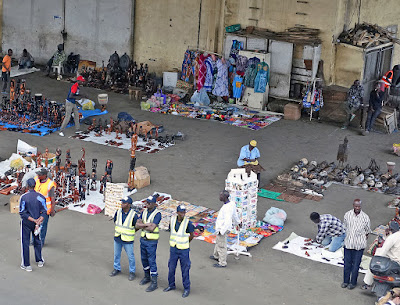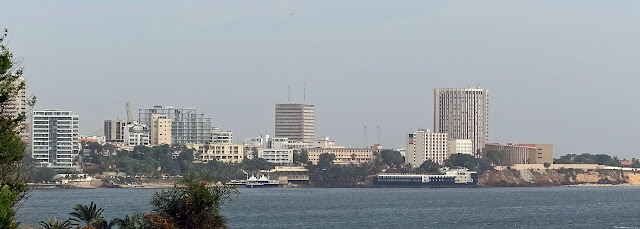Nothing of significance happened on our two days at sea between Las Palmas and Dakar.
November 17
We arrived at the pier in Dakar, Senegal in the morning. I had actually been to Dakar on business for a week in 1981, but had pretty much been limited to commuting between my hotel and government buildings in the center of the city, so I probably didn't have the real "Dakar" experience. Dakar is the capital of Senegal, which was formerly part of French West Africa. The French invested a lot into their colonies, so a lot of relatively well-preserved French Colonial buildings remain. Senegal is a stable democracy, and one of the more prosperous nations in West Africa (which is a relative term).
Our itinerary in Dakar was a city tour, after which I did some more urban hiking around the city. There were other tours available into remote parts of the country, but we opted for the city tour because I wanted to revisit some of the spots I had been at in 1981.
 |
| Awaiting us at the dock in Dakar |
 |
| A view of Dakar from the ship |
 |
| Another view of Dakar |
We started by going through the "colonial" part of town and seeing some French colonial buildings.
 |
| Main train station |
 |
| Guess what this is |
 |
| Another government building |
 |
| A street near the center |
 |
| West African Art Museum (we didn't go in) |
 |
| Some street vendors |
 |
| View of Dakar from the coast. The hotel where I stayed in 1981 is the long low white building on the water in the right center. |
We then went to the largest Catholic church (Cathédrale Notre Dame des Victoires) in Dakar. Senegal is mostly Muslim, but there is still a big Catholic presence.
 |
| Outside the church |
 |
| Church Dome |
 |
| Inside the church |
The church (as you can see) was fairly modern and had lots of neat stained glass.
 |
| Some vendors (far from the last we would see) outside the church |
From the church, we headed to the outskirts of town. During the drive we got lots of views of typical street scenes in Dakar.
 |
| Street maintenance is a bit questionable |
 |
| Typical housing |
Eventually, we arrived at the
Monument de la Renaissance Africaine, which was built in 2010 to celebrate Senegal's 50th anniversary of independence. It cost about $27 million, which was the cause of some controversy.
 |
| A view of Dakar from the monument |
We continued around the coastal area, though some more well-to-do areas of Dakar.
 |
| Some higher-end residences |
|
We then went through/by the University of Dakar, which has about 60,000 students.
 |
| University of Dakar |
 |
| University of Dakar |
 |
| University of Dakar |
After that we stopped in the obligatory craft shop, to see how sand paintings were made.
 |
| Sand painting |
From there, we headed back through town to another craft market.
 |
| Where the oil from Libya goes |
 |
| Fishing boats on the coast |
In every stop in Africa, we were taken to a craft market. As soon as a Westerner enters a craft market, they are descended upon like (I can't think of an analogy that wouldn't be offensive to someone). "Hello sir! Come see my shop! I give you the best price! You speak English? I have cousin in America!" If you make the mistake of expressing interest in an object, you can't leave until you have either bought it or having been made to feel that you are an unworthy person for not having bought it. I'm convinced that someone would sell a lot of stuff by putting out a sign saying "Fixed price--no bargaining". Of course, he would immediately be beaten to a pulp by other other sellers.
 |
| In the craft market |
 |
| Another view of the craft market |
After getting an aerobic workout at the craft market, we headed back to the ship.
 |
| A less prosperous part of Dakar |
 |
| Little Caesar's and KFC appear to have merged |
The "official" ship's tour didn't spend much time in the part of town where I worked in 1981, so I decided to take a walk to the central are (Independence Square) area after we got back to town. In the picture below is the building where I worked (in the center) and the Independence Hotel (where I didn't stay) on the right. In 1981, the Independence Hotel was the swankiest place in town; now it is under renovation. The picture is being taken from Independence Square. From a distance, at least, the area is pretty much as I remember it.
 |
| Another government building, across Independence square |
 |
| Independence Hotel, under renovation |
 |
| Former French colonial building on Independence Square |
From there, I walked back to the ship, stopping first at the main market, and then at a supermarket across the street.
 |
| At the main market |
 |
| In the supermarket |
 |
| On the shelves of the supermarket |
 |
| Beer selection at the supermarket |
That night we took advantage of the opportunity (due to missing two ports) to dine in "La Champagne," the fancy French restaurant on board. Normally this requires a $40 per/person charge, but the charge was waived.
 |
| Inside La Champagne |
The menu was classic French, and I would have ordered one of everything, if I could have. My only regret was that I didn't take the opportunity to order the filet of pigeon. (For those of you who care, I had the lobster salad, pan fried foie gras, lobster bisque, and rack of lamb. I don't remember what I had for dessert, because I had passed out by then :-)
Next:
Day 15: Banjul, The Gambia


